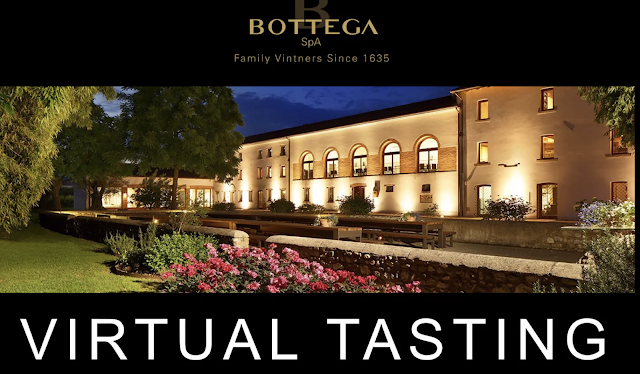Sparkling Online Tasting With Sandro Bottega
Lovely to get an invitation from Bibendum Ireland to take part in an online tasting with Sandro Bottega. Not just virtual. We had real bottles of Prosecco, along with a selection of Italian delicacies.
The Bottega family is no lightweight in the world of wine. Indeed, it is ranked at number two in terms of sales volume, headed only by Moet et Chandon. And the energetic Sandro is no lightweight either - he was The Riedel® Winemaker of the Year Award in 2018 for “having enchanted wine and gastronomic art lovers since 1977, in over 120 countries worldwide, with his artistic skills, the entrepreneurial ability and energy, and the quality and genuineness of the products“.
“So here I am in the Veneto,” he said as he greeted us to his well-laden table. “Forty-five kms north of Venice with the Dolomites to my north. It’s a good place to live: the sea, the vineyards, the mountains.” While they are mainly associated with the Veneto they also have vineyards in Montalcino where they produce some superb Tuscan wines. They also have a distillery where Grappa, Gin and Vodka is produced.It is a major operation, yet so much is done by hand, even down to “manual control of each bottle”. Their preferred option is organic. Their vineyards and wineries are examples of diversity and sustainability. Just a few figures: their CO2 emissions are 88% less than the industry average; they support the Slow Food Foundation for Diversity; Geothermal air-conditioning saves 756 tons of C02 each year; their organic farming techniques avoids using 1000 tons of synthetic chemicals each year. Impressive.
There are of course setbacks. The hail doesn’t know organic from non-organic and Bottega lost 10% of the potential harvest the week before the online tasting. Sandro also pointed out that Prosecco, a symbol of Italian gastronomy and culture, is not a cheap drink to produce. To cultivate one hectare of Prosecco DOCG costs €12,000 while Champagne comes in at €7,500.
So what is the best Prosecco? “The first glass of the day,” according to a smiling Sandro. “That first glass is the best of the day.” Of course, Sandro has no less than 12 Prosecco to choose from! He had another piece of advice: “Drink always with a little bite. A glass of wine is nothing without a good bite”.
Now we began the tasting with POETI PROSECCO DOC BRUT
I have to admit, I began earlier at lunch, pairing it with the suggested San Daniele ham, the White Scamorza cheese and Stiratini (breadsticks). Sandro: “Clean, fresh and fruity. Green apple… golden apple..little bit of pear..even more exotic like peach. It is soft and dry, the aftertaste is also soft with apple and peach. Good with soft cheeses, eg Mozzarella and Scamorza, also prosciutto. Good too with the white asparagus. I like olives myself with it very evening. Great too for cocktails, including Bellini.”
Then we were on to the Bottega Gold Prosecco DOC Spumante Brut
This, like the first wine, is made from 100% Glera grapes. “This is fresher, more complete, more personality, more intensity. Also brut of course but more floral notes and more fruity.” Suggested pairings included: Milano Salami, Parmesan Cheese 40 months, and those Stiratini (breadsticks).
Next up was Il Vino Dei Poeti Prosecco Rosé Venezia DOC Spumante Brut, “a sparkling wine in our tradition”.. “ripe berry bouquet…including cherry..stronger acidity…great with Pecorino or Parmesan cheeses..good value for money..respects our tradition..”. It is made from grapes (Glera 60% and Raboso) grown in the provinces of Trevisio and Venice and is made like Prosecco with the same yeast.
Bottega Pink Gold Prosecco DOC Rosé Spumante Brut is a blend of Glera and Pinot Noir (10-15%). Thanks to the Pinot, this has a light pink colour, the better to see the fountains of very refined bubbles rising. Floral notes and raspberry feature in the gentle aromas and it is quite creamy in the mouth followed by a nutty aftertaste.
Website pairing suggestions Excellent as an aperitif accompanied by mixed Neapolitan fried food, it is a wine for the whole meal that goes well with cold dishes of raw fish (tartare and carpaccio), with radicchio and sausage risottos, second courses of meat and fish not too elaborate, also a pork fillet with vegetables or baked redfish with potatoes.
The final wine was Bottega Rose Gold Pinot Nero Spumante Brut Rosé. “This is a little bit darker. It is 100% Pinot Noir. Raspberry….vanilla…summer flowers…more acidity. Some examples of matching are with chicken, bruschetta with foie gras..pizza (pepperoni)…shrimp., lobster….green asparagus.” Sounds great!
Attention to detail pays off here. The grapes are hand-picked and destemmed. The must is left in contact with the skins for 24 hours at 5 °C. The cold maceration favours the extraction of colour substances and the primary aromas of the grapes.
• The must is separated from the skins using soft pressing. The fermentation takes place at a controlled temperature of 18 °C.
- The base wine undergoes a second fermentation according to the Martinotti method (also known as the Italian Method), in cuve close at 14 °C with the addition of selected yeasts. The wine is left in contact with the lees and finally is filtered and bottled.
Superb sparkling wines, some lovely food and an energetic, efficient and informative host with a great sense of humour. Well done and thanks Sandro!











No comments:
Post a Comment